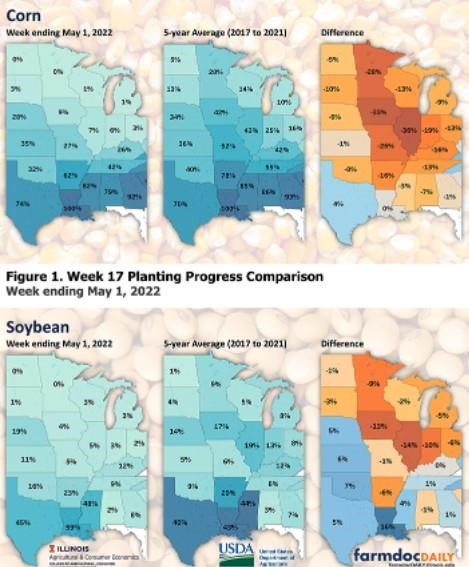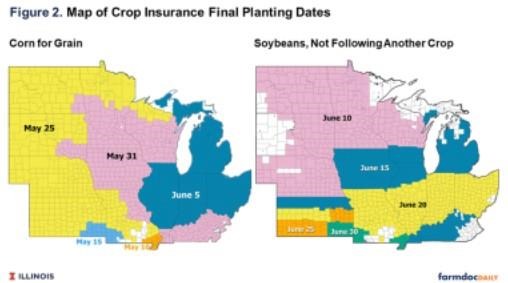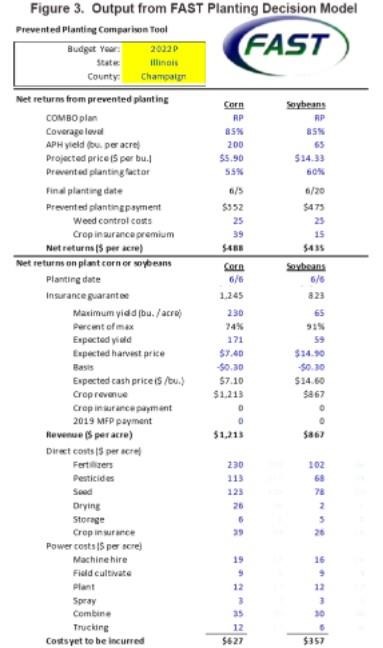By Gary Schnitkey and Jim Baltz et.al
Department of Agricultural and Consumer Economics
University of Illinois
Carl Zulauf
Department of Agricultural, Environmental and Development Economics
Ohio State University
Although planting progress can quickly catch up to average levels with favorable weather, planting progress to date lags across the Corn Belt, almost matching the pace in 2019 when many acres did not get planted. As a result, some farmers in the Corn Belt may not finish planting before reaching the crop insurance “final plant date”, after which taking a prevented planting payment becomes an option. Here we review prevented plant decisions. Unless harvest-time bids fall between now and June, planting corn will have higher expected returns than taking prevented planting payments in early June.
Planting Progress
According to USDA’s Crop Progress Reports, 2022 planting progress lags five-year average progress (see Figure 1). Progress in 2022 also lags 2019 progress when many acres were prevented from planting.

- Illinois: 7% of corn acres were planted on May 1, 2022, well below the five-year average of 43%. Planting progress on May 5, 2019, was 10%.
- Indiana: 6% in 2022 compared to the five-year average of 25% and 3% in 2019.
- Iowa: 9% in 2022 compared to the five-year average of 42% and 36% in 2019.
- Minnesota: 0% in 2022 compared to a 28% five-year average and 6% in 2019.
- North Dakota: 0% in 2022 compared to a 5% five-year average and 3% in 2019.
- Ohio: 3% in 2022 compared to an 8% five-year average and 2% in 2019.
- South Dakota: 3% in 2022 compared to the five-year average of 13% and no planting in 2019.
Again, at this point in the season planting can progress quickly with suitable fieldwork days. For example, in Illinois the entire corn crop can be planted in about fourteen suitable field days (see farmdoc daily, April 21, 2022).
Prevented Planting Payments on Corn
Prevented planting payments are available on the COMBO crop insurance policy on each of its three plans: Revenue Protection (RP), Revenue Protection with the harvest price exclusion (RPhpe), and Yield Protection (YP). Prevented planting payments do not exist for the Area Risk Protection Insurance policy. In addition, use of the Supplemental Coverage (SCO) and/or Enhanced Coverage Options (ECO) do not increase prevented plant payments. With SCO and ECO, prevented planting payments are based on the underlying COMBO product.
Prevented planting payments can be claimed once “final planting dates” are reached. Before the final planting date, farmers must make all efforts to plant corn on intended acres. Final planting dates for grain corn vary across Midwestern states (see Figure 2). May 31 is the “final planting date” for Iowa, southern Minnesota and Wisconsin, northeastern Missouri, the extreme southern counties of Illinois, and Kentucky. June 5 is the date for most of Illinois, Indiana, Ohio, and Michigan.

Once the final planting date has been reached, a prevented planting payment for corn can be taken if corn is not planted for insurable causes (e.g., wet weather). the prevented planting payment will be 55% of the guarantee unless a 5% buy-up option was purchased by March 15. The following example uses the standard 55% factor. Take a unit with a 200 bushels per acre Trend Adjusted — Actual Production History (TA-APH) yield, this year’s projected price of $5.90 per bushel, and an 85% coverage level. In this case, the prevented planting payment will be $552 per acre (200 TA-APH yield x $5.90 projected price x 85% coverage level x .55 prevented payment factor).
Economic Comparisons of Taking Prevent Plant or Planting Corn
This year, projections indicate planting corn will likely be more profitable than taking the prevented plant payment in early June. Figure 3 shows output from the farmdoc Prevent Planting Module, a Microsoft Excel spreadsheet within the FAST series available for download on farmdoc (see Planting Decision Model here). The first column shows net returns from prevented planting ($488 per acre) and for planting corn on June 7 ($586 per acre).

The net returns from prevented planting payments are based on an 85% RP policy with a 200 bushel per acre APH yield and a projected price of $5.90. Planting corn in early June has an estimated yield of 171 bushels per acre, with an expected cash price of $7.10 per bushel. The $7.10 cash price is the harvest-time bid in early May. Costs come from the 2022 Illinois Crop Budget.
Planting corn just after the final plant date has higher returns than taking the prevented plant payment because fall bids are higher than the 2022 projected price of $5.90. As long as harvest-time prices are expected to be above the projected price, planting corn will have higher expected returns than taking prevented planting payments.
Risks occur when planting corn after the final planting date:
- Yields and prices could be low enough that taking the prevent plant payment has a higher expected return than planting corn. Prices could decline over the next month. Yield losses increase as the planting date gets later.
- The crop insurance guarantee is reduced each day after the final planting date, reducing the safety net offered by crop insurance.
- Yields of corn planted after the final plant date will enter into the APH yields, as described in the following section.
APH Yields
Taking a prevented planting payment will not impact the APH yield in future years unless a second crop is planted on prevented planting acres. In the Midwest, most farmers do not plant a second crop as the second crop has to be planted after the late planting period is over.
For example, an insurable unit with 500 acres and 400 acres is planted to corn. Prevented planting payments are taken on 100 acres, and a second crop is not planted on those 100 acres. The yield used in calculating the APH for this insurable unit will be based on production from the 400 planted acres divided by 400 planted acres.
Acres Eligible for Prevented Planting
Each insurable unit will have different acres eligible for prevented planting. Knowing how many acres are eligible is key to not being surprised when making prevented planting decisions. Crop insurance agents can aid in determining acres eligible for prevented planting payments.
As a general guideline, the maximum acres eligible for prevented planting payments equal the maximum acres of corn planted in the last four years in that insurable unit, adjusted for acreage increases, less corn acres planted in 2022. Other planting requirements come into play as well.
As a simple example, take a 100-acre insurance unit that has remained the same size in the last four years. If the maximum number of acres in corn in one of the four years is 75 acres, then 75 acres is the maximum number of acres on which prevented planting of corn can be taken. If this farm gets 50 acres of corn planted, then only 25 acres are eligible for a prevented planting payment on corn.
Farmer-paid Premium and Enterprise Units
Enterprise units have significantly lower premiums than basic or optional units. To be eligible for an enterprise unit, a farmer must plant the lower of 20 acres or 20 percent of planted acres in at least two sections. Note that the requirement is based on planted acres. Prevented planted acres do not enter into the calculations. If no planting occurs, the farm will receive prevented planting payments but will not be eligible for the lower enterprise unit premiums. Premiums will be based on either basic or optional units.
Prevented Planting for Soybeans
Final planting dates for soybeans are different than for corn (see Figure 3). June 15 is the final planting date for Iowa, northern Illinois, Michigan, and Kentucky. June 20 is the final planting date for the southern two-thirds of Illinois, as well as Indiana and Ohio. If needed, analysis of taking prevent plant on soybeans will be considered in another article in the future.
Summary
Despite the lag in current planting progress in the Corn Belt, planting can progress rapidly with suitable field days throughout May. Although it is early at this point to determine if adverse weather will prevent planting of some acreage before the final plant dates, seeing planting progress statistics lagging 2019 is a reminder of the possibility.
The market signals set the 2022 situation apart from 2019. If harvest-time bids do not decline, planting corn late is projected to have higher expected returns than taking prevented plant payments.
Source : illinois.edu